Note: This paper was originally written in 2014. Minor adjustments have been made but all discussions regarding finds within the database reflect data available at that time.
According to its website, ‘The Portable Antiquities Scheme is run by the British Museum and Amgueddfa Cymru – National Museum Wales to encourage the recording of archaeological objects found by members of the public in England and Wales. Every year many thousands of archaeological objects are discovered, many of these by metal detector users, but also by people whilst out walking, gardening or going about their daily work… The Scheme’s database[i] holds records of archaeological finds discovered by members of the public.’ Objects found by professional archaeologists are not included in the database. The database was first made available online in 1999 and by September 2014 about 220,000 objects had been recorded. The majority of items reported seemed to come from the south east of England (Fig 1). In this paper we examine the data relating to thimbles in the database and the database itself and report our findings.

Method
We searched the database for the term ‘thimble’ and 2776 items were found. We downloaded this database into Microsoft Excel and then imported the relevant parts to Microsoft Access. We found that not all of these objects were actually thimbles and after filtering out the non-thimbles including ‘palm guards’, ‘belt buckles’ etc., we were left with 2616 true thimbles to analyse. Some listings were for multiple numbers of thimbles so overall numbers in this paper are only approximate. Whole thimbles and thimble fragments are included. We searched the text for the words ‘copper alloy’, ‘silver’ ‘aluminum’, ‘tin’, ‘gold’, ‘iron’, and ‘lead’, in order to determine and classify the material from which the thimbles were made. We examined pictures of all of the silver thimbles, but there were too many copper alloy thimbles to examine each one individually.
Results
1. Distribution
Overall the distribution of thimbles found seemed to be similar to the overall distribution of all artefacts reported (Fig 2).
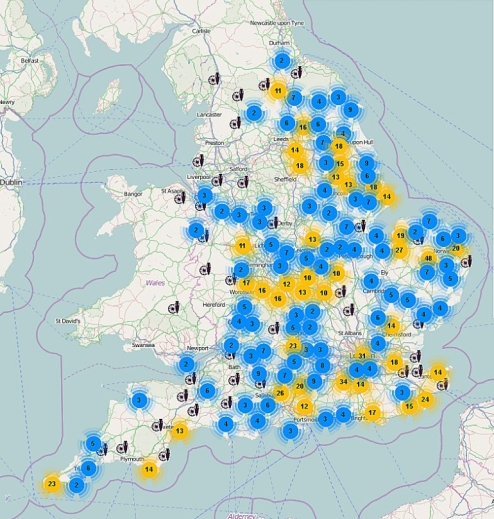
We wondered whether the type of material from which the thimbles were made might have affected their distribution but this seemed not to be the case either. There is a slight pictorial suggestion that there might be fewer silver thimbles found in the North of England and this might be due to the greater affluence existing in the South-East of the country (Fig 3).

The numbers of thimbles reported from each region, however, were too small for any meaningful statistical analysis, although we did compare silver and copper alloy findings in the county with the single largest number of thimbles recorded (Fig 4). Again there was no obvious difference.

107 thimbles were described as modern and these thimbles did seem to be distributed differently (Fig 5). The South-East domination seems to have disappeared.

2. Materials
The majority of thimbles were made of ‘copper alloy’, a term used in the database because, without a detailed analysis of the metal from each thimble recorded, it would be impossible to know visually what to call the material.
| Material | Number |
| Copper alloy | 2367 |
| Silver | 243 |
| Aluminum | 2 |
| Iron | 1 |
| Gold | 1 |
| Tin | 1 |
| Lead | 1 |
The percentage of silver thimbles was twice as great in Norfolk, Lincolnshire and the Greater London Authority area than in Suffolk, possibly an indication of greater prosperity in these three regions, but this may simply be a function of the relatively small numbers of thimbles involved.
| County | Total | Silver | Copper alloy | % |
| Norfolk | 321 | 28 | 293 | 8.7 |
| Lincolnshire | 229* | 14 | 214 | 6.1 |
| Suffolk | 221 | 7 | 214 | 3.2 |
| GLA | 61+ | 5 | 55 | 8.2 |
* one tin, + one iron
218 copper alloy thimbles were described as either ‘acorn top’ or ‘beehive’ in shape but not all thimbles were classified, and not all ‘acorn top’ thimbles were so called (Fig 6, 7).

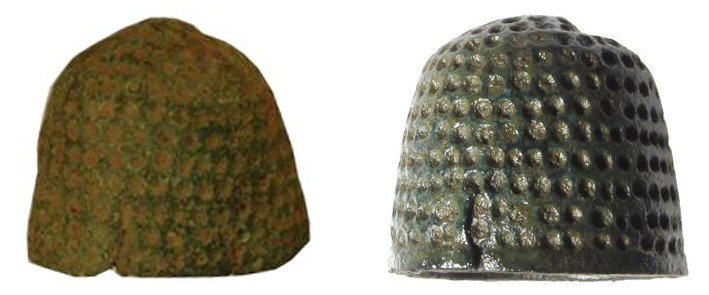
Of the silver thimbles recorded, 54 seemed to be ‘modern’ (19th century and later), 83 were long (mid 17th century), often called Jacobean thimbles (Fig 8) and 84 were short (late 17th century) (Fig 9).


Among the 167 17/18th century silver thimbles recorded there were only four which depicted King Charles II and his wife (Fig 10).

One short thimble had two medallions containing a crowned rose, the symbol of Charles I (Fig 11).

There were nine late 18th century thimbles and some would have had steel tops like the one illustrated (Fig 12).
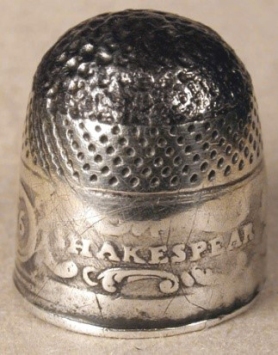
A single damaged silver thimble, missing its steel top, and made by Hester Bateman is recorded in the database. The maker’s initials are clearly seen on the border of the thimble (Fig 13).

13. Inscriptions
41 thimbles were recorded as having inscriptions. Of these, one was an aluminum advertising thimble, one was recorded as medieval (Fig 14), and three were ‘modern’. Six thimbles were made of copper alloy and the remaining 34 thimbles were made of silver.

From the database it was not possible to determine whether the inscription was a motto, maker’s mark or owner’s initials. Inspection of the pictures of the corresponding thimbles indicated that in addition to the single advertising thimble, 16 had mottos and the remainder either had maker’s marks (Fig 15) or owner’s inscriptions (Fig 9, left) or both (Fig 16).


Inscriptions were mainly hand-engraved (Fig 9, 16, 17) although the silver thimble with the clearest motto was not listed as having an inscription (Fig 18, 25).


Many thimbles were so damaged that it was very difficult to read the inscription from the picture (Fig 19).

A maker’s mark on a post-medieval thimble was recorded as ‘HC&S’ although the thimble was hallmarked in 1928 and the maker was Henry Griffith and Sons (HG&S) of Birmingham.
4. Other findings
Some thimbles seemed to have been cut down to very thin bands, presumably to be used as decorative finger rings (Fig 20). Two such thimbles were found.

Some thimbles were described as ‘double skinned’ (Fig 21) and, in the past[ii], we considered that two pieces of brass had been mistakenly deep drawn into a thimble.
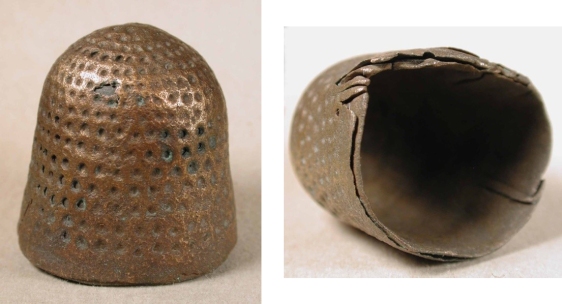
Six such thimbles were recorded in the database. The finding sites were widely scattered and so we are now wondering whether this was not an accident but a deliberate method of construction, although we do not know why this might have been done.
Several of the thimbles recorded showed features that, as far as we know, have not been recorded in the thimble literature and they are illustrated below.
The only short strap work thimble that we have ever seen has a maker’s mark ‘AW’ and a rather unusual top (Fig 22).

This unusually shaped early strap work thimble might represent a stage in the progression from tall cylindrical silver thimbles to the later and shorter stubby silver thimbles (Fig 23)

Another thimble looks to be missing a top (Fig 24) but was it removable or does this thimble demonstrate yet another method of construction?

Niello thimbles were very rare in the 18th century and only one other is known (Fig 25). The found thimble has an ornate top and the inscription ‘+AFENDE +TO+THE+ENDE’ around the border (Fig 26). There is a makers mark ‘RL’ inside the rim. Another thimble (Fig 9, second from left) has a similar maker’s mark and these two thimbles are said to have been made in Holland by the recorder but this seems unlikely.


Two of the shorter 17th century silver thimbles had interesting bands (Fig 27) and one had an unusual top for a short thimble (Fig 28)


Finally, we found a couple of thimbles with medallions containing what looked like cupids and a bleeding heart overlying several arrows (Fig 29). These 17th century keepsake thimbles are exceedingly rare.

The database
A database of this sort with many different recording officers is fraught with problems when it comes to analysing the recorded information. The organisers are to be commended on the mammoth project that they have undertaken and for the establishment of a searchable database. By nature of its organisation however it is subject to many limitations, many of which have only become apparent to us as a result of our study of the thimbles in the database.
The registration rate for the Portable Antiquities Scheme is unknown and therefore the total number of thimbles found and not reported is unknown. The majority of thimbles were found by metal detectors so this must necessarily bias the distribution of the thimbles found to the areas in which metal detectors are used most frequently. The distribution of thimbles and their types found must therefore be biased somewhat and cannot truly represent the distribution of thimbles in England and Wales during the 17th and 18th centuries. In addition, many of the more expensive thimbles, for example, might still be in aristocratic households or lost in the grounds of stately homes and therefore not available for metal detection. In the absence of any other archive, however, the database is invaluable as a window into the past.
Occasionally recordings were brief, some were duplicates and this made analysis crude at best. Not all recorded thimbles were described and often database fields were left blank or incomplete. When the search term ‘thimble’ was used online, finger guards (could be considered to be a form of protection for sewing but not really thimbles), a buckle, rings, crotal bells and a whistle were found in the listing. Silver thimbles were described as ‘cast’ when they had been milled in two parts. Some thimbles were described as ‘acorn’ shaped whilst similarly shaped thimbles were not described in this way by other recorders (see above, Fig 6, 7). The term ‘medieval’ was not used in the same way by all recorders and some so called ‘medieval’ thimbles were from a much later period. These inconsistencies, arising from the multiplicity of the recorders, made analysis difficult and somewhat limited. Clearly defined parameters for specific fields in the database, to be used by all recorders, might limit some of these problems and even insisting that all fields be filled would be a help. From a research standpoint the standard of data recording must be improved. We do not underestimate the difficulty of this task although the quality of recording in another multiple-user metal detecting database does seem to be much higher [iii].
Conclusions
The data presented in this paper represents our analysis of the thimbles recorded in the Portable Antiquities Scheme database [circa 2014]. The results are limited by the biases described above in relation to the data itself, the data collection and recording and possibly the fact that thimbles form only a small fraction of the database and maybe there are many more items which are considered to be more important than thimbles to the recorders. Nevertheless, the database is a valuable instrument for learning more about thimbles from the past. It is hoped that it will become even more useful if recording methods are standardized and all recorders enter consistent data into all the fields in the database. At the present time the database is more useful for qualitative rather than quantitative studies.
All images, unless otherwise designated, were downloaded from the PAS website.
Notes
[i] Portable Antiquities Scheme. http://finds.org.uk/database
[ii] Isbister M, Isbister W. Early English Thimbles, 2011. Thimble Collectors Bulletin, winter.
[iii] UK Detector Finds Database. http://www.ukdfd.co.uk/
Addendum
The UK Detector Finds Database is a voluntary, hobby-based database for objects detected with metal detectors. One of its aims is to ‘encourage those detectorists who would not otherwise record their finds to do so by making use of the UKDFD self-recording facility and to ‘encourage the recording of post c.1650 finds, many of which are not eligible for inclusion on the Portable Antiquities Scheme (PAS) database’. Criteria for finds entry are clear and certain fields are mandatory. The standard of photography is high and the descriptive data is good as a result. The database itself is internet-based and can be analysed to some degree but not as easily or as fully as the PAS database. There are 451 thimbles recorded at the time of writing (October 2014) and 70 of these are silver thimbles. The silver thimbles are, in general, of the more modern type (Georgian onwards). The remaining thimbles are of copper alloy and include many early ‘acorn’ and ‘beehive’ thimbles. The detectorists seem to have a greater knowledge of thimbles[i] than the recorders of the PAS. As a result of the criteria for entry and selectivity of finds however, analysis, in detail, of the database is difficult and the results would necessarily be rather biased.

Three notable copper alloy thimbles found in the UKDFD:

Three interesting silver thimbles found in the UKDFD:
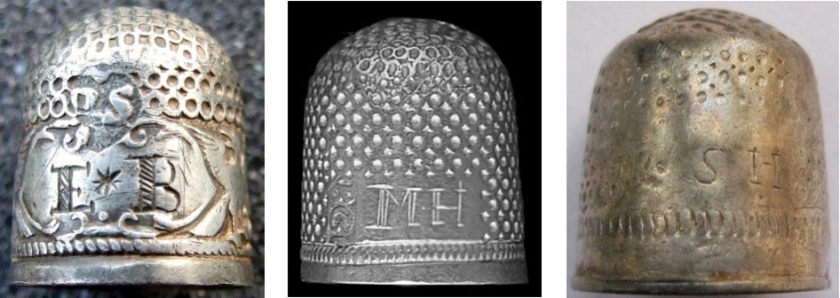
The right thimble is a very worn and possibly a little earlier version of the other two!
Notes
[i] UK Detector Finds Database: Thimbles. http://www.ukdfd.co.uk/pages/thimble.html
Sincerest thanks to Magdalena and William Isbister for their kind permission to reproduce their 2014 article on the Archaeopress Blog.
Continue reading “Old Thimbles and the Portable Antiquities Scheme”

